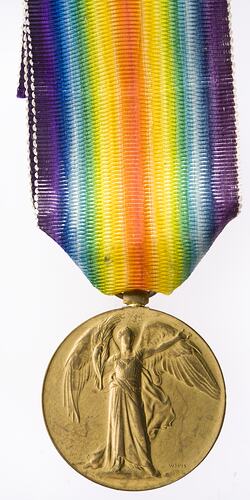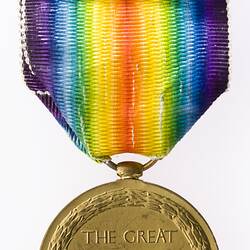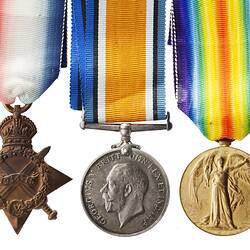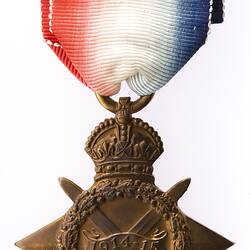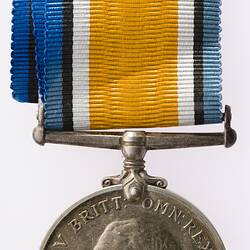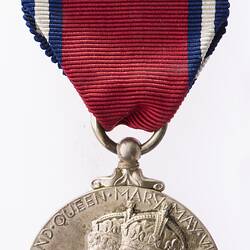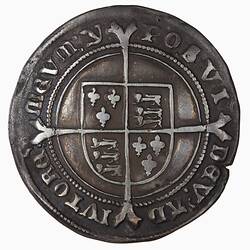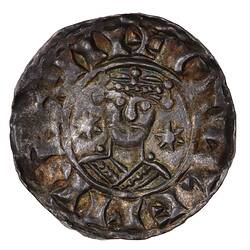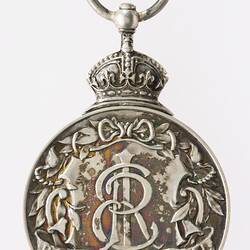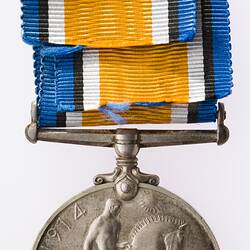Summary
Victory Medal 1914-1919 with ring mount and ribbon awarded to Surg. Gen. Richard Herbert Joseph Fetherston, A.I.F.
Dr. Fetherston had previously served as a Captain with the Victorian Militia when he enlisted with the Australian Imperial Force in August 1914. He was officially 'taken up' on August 15, 1914 as the Director-General of Medical Services (DGMS). He was gazetted as a Colonel in 1915 and as Surgeon General in 1916.
Although he had enlisted for active service, Fetherston was based in Melbourne throughout the war having been deemed 'indispensable' to Australia. Despite this, he was sent on two inspection tours of the Australian Army Medical Corps overseas and was responsible for the reorganisation of the corps.
Fetherston is commended in the Official History for his abilities and devotion to duty. Surgeon General Fetherston retired from military service in 1919.
According to the terms of his will, Fetherston's medals (and those of his father) were left to his two sons - Gerald and Herbert Fetherston. They were later donated to the National Gallery of Victoria and subsequently transferred into Museum Victoria's collection.
The Victory Medal was authorised in 1919 and was awarded to army, navy and air force personnel who served in a theatre of war between midnight 4th-5th August 1914 and midnight 11th-12th November 1918. The Allies resolved that, if they wished to issue a Victory Medal, it would share a common feature of a depiction of Victory on the obverse and a ribbon of red, yellow, green, blue and violet merged into a rainbow pattern. This medal, that of Great Britain, was awarded to personnel from countries in the British Empire (some 5,725,000 were issued). The other Allied countries that issued Victory medals were: Belgium, Brazil, Cuba, Czechoslovakia, France, Greece, Italy, Japan, Portugal, Romania, Thailand, Union of South Africa and the United States of America.
Obverse Description
Figure of Victory facing three-quarters right with wings spread; in her right hand she holds a palm branch, her left hand is extended and open. The artist's initials, W.McM. (W. McMillan) are above the ground line on the right.
Reverse Description
The words, 'THE GREAT . WAR FOR . CIVILISATION 1914 - 1919' within a circular wreath of laurel.
Edge Description
Text; 'SURG. GEN. R.H.J. FETHERSTON A.I.F.'.
More Information
-
Collecting Areas
Medicine & Health, Numismatics & Philately, Public Life & Institutions
-
Acquisition Information
Transfer from National Gallery of Victoria (NGV), 15 Mar 1976
-
Date Issued
1919 AD
-
Issued By
-
Mint
-
Artist
-
Awarded To
-
Place
Gallipoli Peninsula, Turkey
Place medal recepient served -
Inscriptions
Obverse; 'W.McM.' (W. McMillan - artist). Reverse; 'THE GREAT . WAR FOR . CIVILISATION 1914-1919'. Edge; 'SURG. GEN. R.H.J. FETHERSTON A.I.F.'.
-
Material
Silver
-
Axis
12
-
Classification
-
Category
-
Discipline
-
Type of item
-
Dimensions
50 mm (Height), 36 mm (Outside Diameter)
Height to top of ring
-
Shape
Round with loop and ribbon
-
References
Ancestry.com Australian Dictionary of Biography Butler, A.G., Official History of the Australian Army Medical Services, 1914-1918 Fetherston Family Papers held at the State Library of Victoria (MS 9865) National Archives of Australia Public Records Office of Victoria: Will, Richard Fetherston - VPRS 7591; 346/451
[Book] Joslin, E C., et al. 1988. British Battles and Medals., 230 - 1 Pages
-
Keywords
Australian Military Forces, Medical Corps, Wars & Conflicts, World War I, 1914-1918
